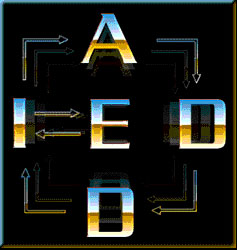


Instructional Systems Design (ISD) is a systemic and systematic process for creating instructional solutions to performance problems based on a combination of practical experience, theory, research and data gathered from field settings. ISD is systemic in that it views organizations and human performance as a system; a set of interrelated components that must work together to achieve a common goal. ISD is systematic in that it follows an orderly process that consists of 5 basic iterative phases, including: analysis, design, development, implementation and evaluation (Figure 0.1). Some suggest that ISD is updated and recommend rapid prototyping or more “agile” design and development processes, such as SAM and SAM2. Experts in the field realize that agile processes also include analysis, design, development, implementation and evaluation phases (so we are not actually leaving ADDIE for SAM as some suggest) but rather reconceptualizing how we complete the 5 basic problem solving phases.
Instructional solutions may include, but are not limited to instructor-led courses, workshops, and seminars, self-instructional print materials, instructional videos, computer-based training/instruction, web-based training/instruction, and instructional television (ITV). The systematic tasks addressed in this course (e.g., conducting instructional analyses, defining objectives, determining assessment methods, generating an instructional strategy) are believed to be relatively generic to the design of most forms of instruction. Differences are thought to be more prominent in the development, rather than the design phase of the overall process.
For example, during the development of instructor-led materials, an Instructional Technologist may create drafts of instructor guides and student materials. In comparison, the development of computer or web-based instruction may require Instructional Technologists to create storyboards, flowcharts and electronic prototypes. Instructional Technologists developing instructional videotapes may produce camera shot sheets and scripts for actors.
It is recognized that there are many reasons why people do not perform (e.g., inappropriate incentives, inadequate tools, lack of motivation, wrong personnel, dysfunctional work environment). Systematic design begins with the assumption that a needs assessment (aka. training needs analysis, performance analysis, front-end-analysis) has been conducted and has determined that instruction is appropriate for addressing a performance problem that is due to a lack of skills and knowledge. Be sure to note: Needs assessment is a key concept associated with Instructional Technology but is only noted here because its relationship to systematic design is discussed in Chapter 2 of the Dick, Carey, & Carey (2009) course textbook and addressed in detail in EME6607 Planned Change. This overview of Instructional Design is divided into three sections:
The systematic design process consists of five iterative phases including (a) analysis, (b) design, (c) development, (d) implementation, and (e) evaluation. Table 0.1 lists tasks associated with each phase along with a sample of related products. One of the key characteristics of systematic design is that the products of one task are used as input for successive task. For instance, the analysis charts, maps and reports are used to generate, cluster and sequence performance objectives. In turn, the performance objectives are used to determine learner assessment methods and generate instructional strategies, and so on.
Table 0.1 Systematic Design Tasks and Resulting Products
PRODUCTSThere are a number of benefits associated with applying systematic design tools, techniques and procedures. Systematic design is:
Along with the benefits, there are several limitations associated with applying systematic design tools, techniques and procedures. The model posited by Dick, Carey and Carey (2005):
Note: Much of the online information provided in each unit of this course has been written to address the limitations noted above.
To help you gain further insights into the nature of systematic design, I will compare the process to related fields of studies, including learning theory, curriculum & instruction, instructional/educational technology and performance technology.
Cognitive and educational psychologists study how and why people learn. Cognitive psychologists tend to focus on the mental process associated with learning, where as educational psychologists are more inclined to examine learning events or experiences. Both generate theories of learning that seek to explain the results of given events. Learning theories range from behaviorist to cognitive information processing to cognitive constructivist perspectives. These learning theories, in turn, serve as the foundation for instructional design models and theories.
Learning theories differ from instructional design theories in that they are descriptive in nature. They seek to describe how learning occurs. In contrast, instructional theories and models are prescriptive in nature. They seek to identify useful methods for stimulating learning in particular situations based on particular learning theories. For this course, we will study the Dick, Carey and Carey (2015) model for instructional design that is based primarily on Gagnes (1985) instructional theory. The model specifies tools and techniques for analyzing, designing, developing and formatively evaluating instruction based Gagnes five domains of learning. Gagnes domains, in turn, is an instructional theory that is based on cognitive information processing theories of learning.
In many ways, the tools and techniques used in the systematic design process mirror the methods utilized by educators trained in Curriculum and Instruction (C&I). Pre-service teachers and practicing educators in undergraduate and graduate C&I programs learn to design, develop, implement and evaluate instruction. They learn about objectives, instructional strategies and learner assessments. They read theorists and researchers such as Gagne, Piaget, Bruner and Vygotsky. However, systematic design does differ from C&I in a number of significant ways. For example, systematic design:

Systematic design, also known as instructional systems design (ISD), is one core process associated with the field of Instructional Technology. As an eclectic field, instructional technology takes what we know about teaching, learning, systems, communications, media and other related areas to create training and instructional solutions to performance problems in various settings (e.g., K-12, higher education, military, business and industry). Figure 0.2 illustrates the relationship between Instructional Technology and its foundations.
Systematic design is one basic process used to develop such solutions. There are a number of different systematic design models (c.f., Andrews & Goodson, 1980; Reigeluth, 1983; Branch & Gustafson, 1997). While they differ in foundations, tools and techniques, they all follow some type of orderly process. For this course, you will learn an enhanced version of Dick, Carey and Carey’s (2005) model for instructional design.
The systematic design of instruction forms a part of the larger field known as Performance Technology. They are similar in that they both:
They differ in that systematic design begins with the assumption that instruction is the best method for enhancing human performance. Performance Technology (PT) makes no such assumptions and prescribes a needs assessment in order to determine the best method(s) for promoting performance for which instruction is only one of numerous possibilities (e.g., personnel selection, culture change, organizational design, incentive systems). Table 0.2 illustrates the differences between PT and systematic design in further detail.
Table 0.2. Significant Differences between PT and Systematic Design